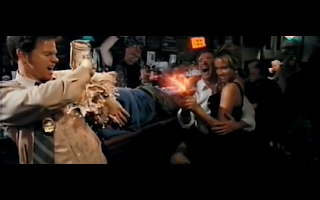 |
| beer spilling and gunshot frozen in time |
 |
| frozen popcorn pieces |
I instantly wanted to delve into how this shot was created! I searched the web and found a few similar sequences that resembled this bullet time frozen effect. The first instance I stumbled on was a commercial Philips had produced about 3 years ago. The video followed a heist situation gone wrong, one tracking shot of an entire hospital complex...oh yeah, and everything was frozen in time. In order to achieve the amazing sequence, 3 different motion control rigs were used to keep shots consistent and exact. Then, two shots were filmed for each segment of the video,
one as a clean pallet at 24 fps, and then a second at 48 fps with actors in the shot so their slight movements would become less noticeable. Another technique used was to shoot the scene at an extremely high frame rate (about 750fps) so that the actors slight movements were not picked up in the final composition.
Realizing I had none of this equipment or capability, I looked to alternative ways to sell my shot. I knew I wanted a single tracking shot of a college freshman floor. The shot would have total chaos ensuing on the floor, and then end with one student trying to study and breaking the frozen shot when yelling at his floormates to shut up. However, achieving this shot proved to be difficult even before sitting down with my friend, Andrew Kuserk, for the 3D post production.
I started testing about two months before even starting production in order to see what type of camera I should use. After several failed attempts using a high speed point and shoot camera I own, I decided it would be best if I used a high definition camera at 60fps. Though the high speed camera could shoot at 220 fps it was just too low a resolution. After some testing with actors holding positions at 60fps and slowing that footage to 30 fps in after effects, I found a pretty good balance between semi high speed and quality. I also utilized the warp stabilizer in after effects as well as other tools to help clean up my footage. Next came production.
No comments:
Post a Comment